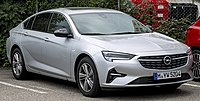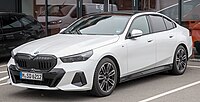Excepting those of the Europe-wide safety assessment program Euro NCAP, vehicle segments in Europe do not have formal characterization or regulations.[1] Although the definition is vague, there is little overlap between segments A–F based on weight and size parameters.[2]
Models segments tend to be based on comparison to well-known brand models. For example, a car such as the Volkswagen Golf might be described as being in the Ford Focus size class, or vice versa. The VW Polo is smaller, so it belongs one segment below the Golf, while the bigger Passat is one segment above.[3]
The names of the segments were mentioned, but not defined, in 1999 in an EU document titled Case No COMP/M.1406 Hyundai / Kia Regulation (EEC) No 4064/89 Merger Procedure.[1]
| Code | Meaning | Example | Image |
|---|---|---|---|
| A | mini | Fiat 500 | 
|
| B | small | Renault Clio | |
| C | medium | Toyota Corolla | 
|
| D | large | Opel Insignia | 
|
| E | executive | BMW 5 Series | 
|
| F | luxury | Mercedes-Benz S-Class | 
|
| J | sport utility | Jeep Wrangler | 
|
| M | multi-purpose | Volkswagen ID. Buzz | 
|
| S | sports | Audi TT | 
|
- ^ a b "Regulation (EEC) No 4064/89 - Merger Procedure" (PDF). Office for Official Publications of the European Communities L-2985 Luxembourg.
exact market definition was left open .. boundaries between segments are blurred by factors other than the size or length of cars
- ^ Christian Thiel; Johannes Schmidt; Arnold Van Zyl; Erwin Schmid (16 February 2014). "Cost and well-to-wheel implications of the vehicle fleet CO2 emission regulation in the European Union". Transportation Research Part A: Policy and Practice. 63: 27+28. doi:10.1016/j.tra.2014.02.018. Retrieved 25 August 2016.
There is no or very little overlap between the traditional segments A to F
PDF EU headliner - ^ "Car Classes Simplified: The Euro-standard Car Segments". AutoIndustriya.com. 9 March 2016. Retrieved 25 August 2016.